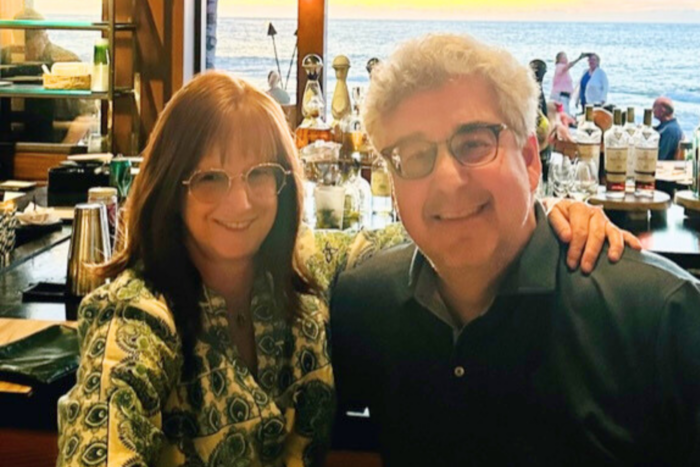By Tina Moss
This is my hair journey. There is no right or wrong way to think about and approach the issues of sparse hair, hair loss or baldness, and I don’t profess to know about or be an expert on anyone but myself. Any judgements and opinions I express in this piece are about me and my experiences only. Everyone’s path is different, and this is mine.
How My Thinning Hair Impacted Me
I am a 61-year-old woman with hypohidrotic ectodermal dysplasia (HED). Over the course of my life, I’ve dealt and suffered with the most common symptoms of HED: missing and misshapen teeth; inability to tolerate heat; eczema; and thin hair. Until several years ago, I’d managed to make peace with everything except my hair; my fine, increasingly thinning hair.
I could not style my hair, look in any mirror, or be around women with normal, let alone thick hair, without feeling self-conscious, awkward, and on days when my self-loathing was especially strong, as if the condition of my hair was somehow a personal failing.
I have two younger siblings neither of whom is affected by HED, both of whom have amazingly lush heads of hair. My parents were also well endowed in the hair department. Growing up, I was an outlier, the one who stuck out in family pictures, or at least that’s how it seemed to me. Looking back, I realize that my perceptions were in all likelihood at odds with what others saw. I was the one focusing on what I considered to be my faults. Other people though? Probably not so much. But until 2019, when the COVID pandemic hit, I was unable to view myself this way.
As I aged and my thin hair became thinner and my scalp more visible, I began to obsess. I didn’t want to live the rest of my life with less and less hair, having to request that my husband arrange the hair on the back of my head to cover especially sparse areas, worrying that people were judging me, and feeling sorry for myself. I knew that at some point I would have to do something.
If you or someone you love has hair affected by ectodermal dysplasia, download our new Sparse and Brittle Hair Guide written by dermatologists. This resource outlines practical tips for preventing hair loss and breakage; hair care products to try, the truth about hair growth products, hair implants and hair extensions, and information about wigs.
Wig or No Wig?
For me, the answer seemed to be wigs. But contemplating this sent my brain down a rabbit hole full of questions and concerns. How would I go about finding a good wig? What would I look like in a wig? Would I feel like a fraud? Should I try to get a wig that looked like my usual style? Did I dare even consider a wig with the flowing hair I always wanted? What would people who knew me think of me if I started wearing a wig? Would the people at the pharmacy, the market, my favorite restaurant, my dentist judge me or make up stories in their heads about me? What would my husband think?
What all of this boiled down to was fear; fear of change or that I might not be able to find a workable solution. The script of anxiety that circulated in my head went something like this: I am going bald; what will I do, if anything: wigs might be a solution: but, but, but; inertia; worry; logistical problems, who, how, where, when; what will people think; I am ugly and will get uglier; how will I know when I should act; shame, worry, more self-loathing. Rinse and repeat.
One day I was done, it was all too exhausting. While engaging in one of my occasional internet searches on places to purchase wigs in Los Angeles, I came across a woman who owned a small shop catering to people with medical hair loss. I probably passed over the listing for her shop multiple times, but this time I clicked and entered a world where hair loss wasn’t stigmatized, women were considered beautiful with or without hair, and wigs were just normal part of life.
This was a classic case of “when the student is ready, the teacher will appear.” Intellectually, I had always known there were many places to find wigs in Los Angeles, but this time while perusing wig websites something shifted inside of my head. Enough, I thought. Enough perseverating, worrying, and fretting. I dialed the number listed, talked to the shop owner and made an appointment for a consultation.
My Husband’s Reaction

Tina and her husband, Richard
It took me two days to tell my husband of my decision. I’m not sure how I thought he was going to react but all he said was something to the effect of, “you’re beautiful no matter what, but if this will help you feel better about yourself, then do it.” It was kind of a nonevent. I can best describe my consultation and subsequent first purchase of a wig as surprisingly freeing and without angst. The experience signified the start of an internal shift away from shame and self-consciousness and toward self-acceptance and taking an active role in choosing how to present myself.
My first wig was fairly similar to my style and color of hair, just much more. When I began wearing it, I was nervous about how others would see me. I found that reactions were consistently positive and encouraging. I also purchased a second wig that represented the head of hair I always wished I had: just below shoulder length, parted slightly on the side, with bangs. I named her Cher. She would be my alter ego wig when I became brave enough to wear her out and about.
It took some getting used to toggling between wigged Tina and un-wigged Tina, and before I could really sink into my new look, the COVID pandemic hit. For two years, my wigs lived on their Styrofoam heads while I stayed home and avoided getting sick. I put the whole hair situation on hold as the world shifted and eventually resettled.
My Hair, My Way
Once COVID abated enough for me to feel comfortable going out and about, I put a wig back on. I decided to put aside my first short wig and wear the longer, more daring one. The reaction people had to me was startling and fun. People I knew who hadn’t seen me in a long time commented on how good I looked, they noted that I’d grown out my hair and how this made me look younger. It’s true, I did look about ten years younger, and although that hadn’t been my intention I wasn’t going to complain.
People I saw occasionally commented positively on my appearance without mentioning my hair. Sometimes I’d take the compliments and move on. Other times, out of a desire for full disclosure, I would thank them and then tell them I was actually wearing a wig. Gradually I relaxed into the situation and stopped feeling the need to explain anything.
Now, when I’m at home I don’t wear a wig. I let my crazy, short, thinning, slightly curly hair do its thing. When I go out in the world sometimes I wear a baseball cap, other times I wear a wig. When meeting up with friends, going to an event, or when I want to have a feeling of optimal confidence, I put on a wig (either “Cher” or “Rita”, a fun red number with beach waves).
It’s taken some practice to feel completely comfortable rocking my wigs but each time I wear one, I grow more at ease and care less about whether people might think.
I intellectually know that most people are too busy with their own self-doubts and judgements to focus on me and when I notice myself slipping into a state of self judgement I remind myself of this.
Finding Peace
I find that my wigs allow me to be my full self when I’m around other people. Rather than being concerned about other’s judgements, or judging myself, I focus on being present, on functioning without the self-conscious filter through which I’d viewed the world most of my life.
Wigs are the tools I choose to use in order to navigate my world in a more positive way. Underneath my wigs I am still me, the personal issues I struggle with are still there; that work is never-ending. But they do allow me to relax and just be myself.
For the first time in my life, at 61, I am at peace with my appearance. Now I control the narrative of how I look.
Life is simply too short.
Tina Moss is a guest blogger for the National Foundation for Ectodermal Dysplasias. She lives in Los Angeles, California, with her husband, Richard. You can read her other NFED blog, “A Mom’s Take on the Dental Implant Journey.”
Apply for a Free Wig
The NFED has many wigs that have been donated that we are giving away for free to individuals affected by ectodermal dysplasias. Learn more and apply to receive a free wig.

I have new wigs I purchased on clearance from Paula Young that are various Greys that just didn’t work for me but were non-returnable. I’m happy to donate! I live in St Charles, MO. How do I get them to you.
I have Ectodermal Dysplasia but undiagnosed which form. I’m 71 years old so therefore not diagnosed until late 1980’s after being married with two children.
Hi, Ann! That is such a kind offer to donate your wigs. Could you email us at info@nfed.org about the donation and how we might be able to get the wigs to our office? Many Thanks! – Veronica
Amen sister. What a relief not to have to struggle with thin, fine hair and bemoan not looking like other women. I started wearing wigs after seeing photos of myself with my first two grand babies. Get compliments all the time and often tell people it’s a wig! I think that reflects confidence AND may encourage them to feel free to confront their challenges. So, wind and humidity and embarrassment TAKE THAT!
Thank you for sharing your hair story! Much wisdom in there.